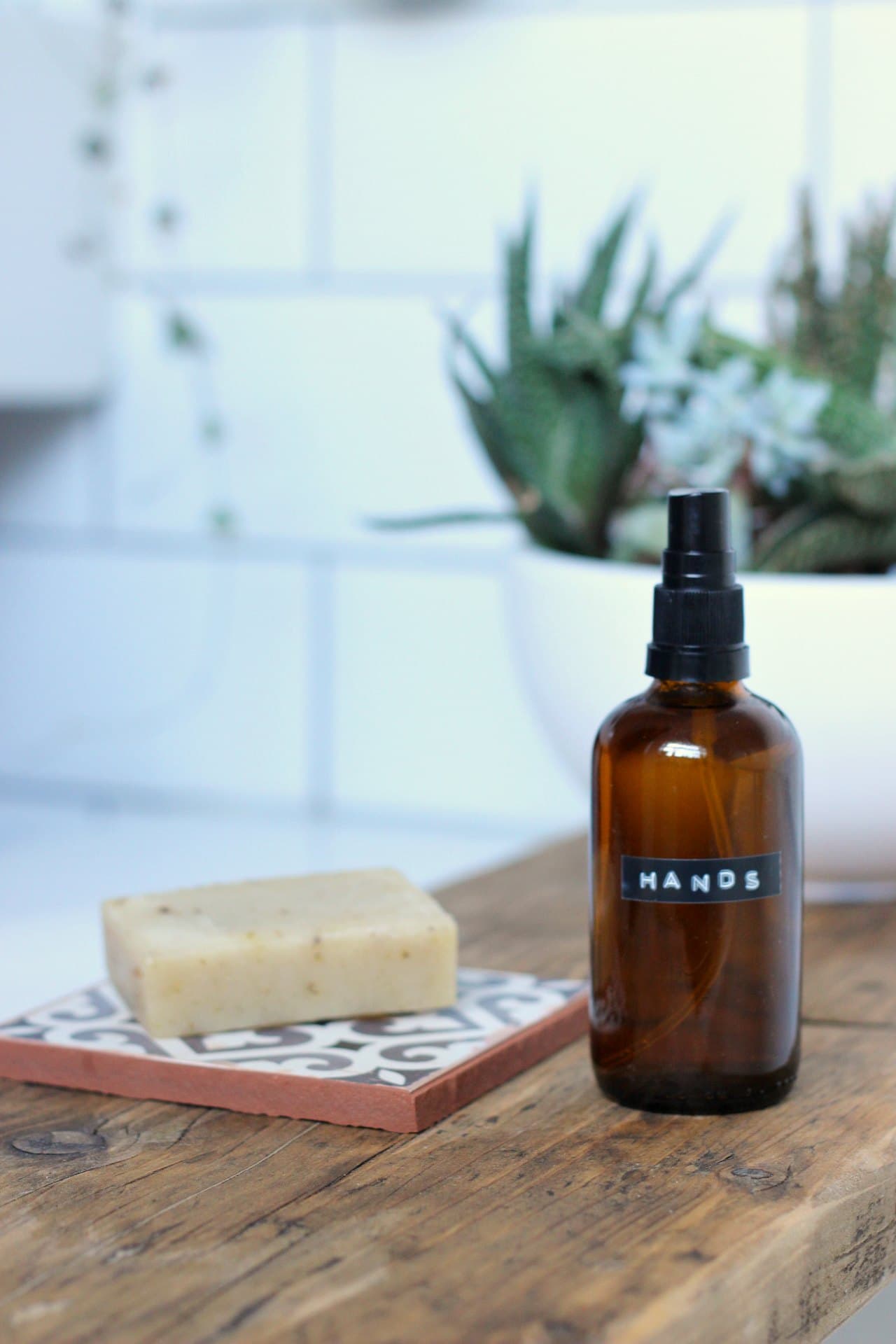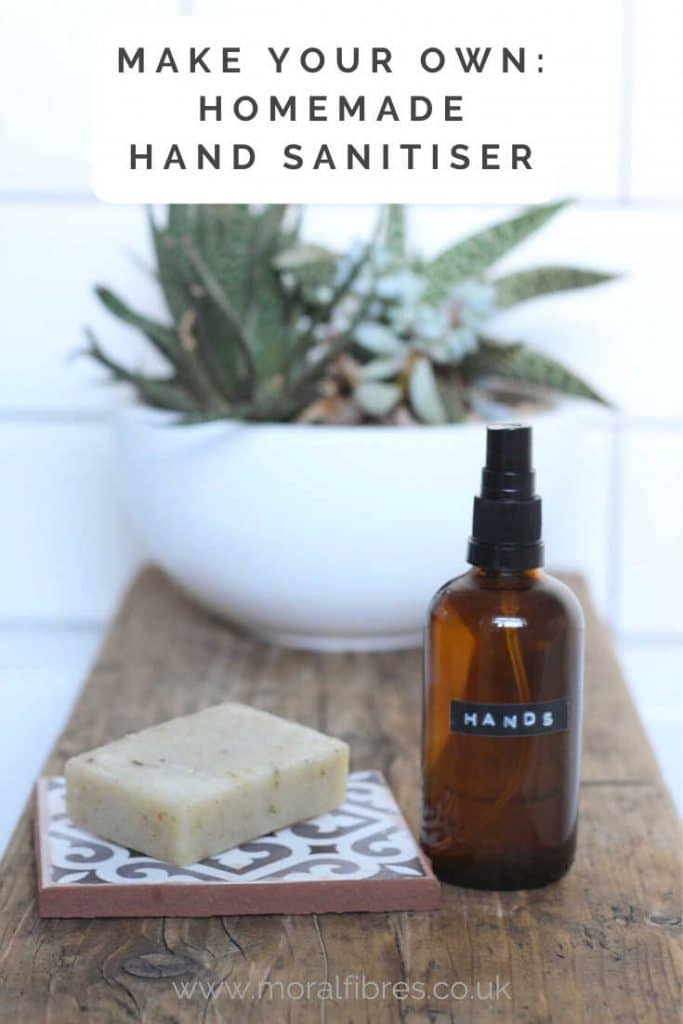Homemade Hand Sanitiser Recipe – WHO Formulation
To support the running costs of Moral Fibres, this post contains affiliate links. This means Moral Fibres may earn a small commission, at no extra cost to readers, on items purchased through these links.
DISCLAIMER: This homemade hand sanitiser recipe is not a substitute for proper handwashing.
Last year I made some homemade hand sanitiser that I have been meaning to share with you. I have two young kids, aged 8 and 12. Whilst my kids are great at getting into messes when we’re out and about, I have to hold my hands up and say I’m an expert at it too!

Also, have you seen the original Trainspotting movie? If so, then you’ll know the scene with the worst toilet in Scotland. Admittedly, whilst not as bad as that toilet, I’ve definitely found a few contenders in and around Edinburgh. Whilst I would always prefer to wash my hands with soap and water, hand sanitiser is definitely a handy thing to carry in those times.
In recent times, hand sanitiser has been tricky to get hold of, so here’s a homemade recipe if you ever find yourself in a pinch.
I’ve updated this recipe because my original recipe contained witch hazel. This isn’t strong enough against COVID-19. As such, I’ve updated this recipe to make it compliant with the Word Health Organisation’s (WHO) recommendations for making hand sanitiser. This means that has been proven to kill harmful micro-organisms on your hands.
The Homemade Hand Sanitiser Ingredients
The three main ingredients of the WHO-recommended hand sanitiser spray are:
- Isopropyl alcohol 99.8% provides germ-killing properties, through its high alcohol content.
- Hydrogen peroxide at a dilution of 3%. Hydrogen peroxide is a mild disinfectant that kills yeasts, fungi, bacteria, and viruses. It’s safe to use on your skin and is often prescribed by dentists for swollen gums.
- Vegetable glycerine acts as a moisturiser to avoid your hands drying out from the high alcohol content of the isopropyl alcohol.
I have also added some essential oils, to add some scent. The essential oils may also boost the antibacterial properties of this homemade hand sanitiser. However, you can leave them out if you want. The irony here is that the essential oils are not essential!
If you do want to use essential oils, I chose lemongrass essential oil for this homemade hand sanitiser recipe because of its proven antibacterial action. This scientific study showed that lemongrass oil is even effective against drug-resistant organisms.
Please note, that lemongrass essential oil can be too strong for sensitive skin. If you are sensitive to lemongrass, consider another essential oil with germ-killing properties, such as tea tree oil.
I also chose lavender essential oil for its antibacterial action. Lavender oil has proven effective against e-coli and MRSA in scientific studies.
Essential oils aren’t recommended for use on children younger than two. Again, doing a bit of research on essential oils if you decide you want to is always highly recommended.
As always, keep your essential oils and the finished product out of the reach of children, and only use them under direct adult supervision.
How to Make WHO-Recommended Homemade Hand Sanitiser

Makes 3 x 100 ml bottles of hand sanitiser – one for your bag, one for your hallway, and one for your car.
Homemade Hand Sanitiser Ingredients
- 3 x 100 ml glass spray bottle (use an old one if you have one. You can also use an old plastic bottle. Sometimes over time, the essential oils can eat away at the plastic so just be mindful of that if you are using essential oils. However, if there’s less chance of it breaking in your bag then plastic is a better choice).
- 175 ml Isopropyl Alcohol (99.8%)
- 1/2 tablespoon Hydrogen Peroxide (3%)
- 2 teaspoons vegetable glycerine
- 90 mls cooled boiled water
- 10 drops Lemongrass essential oil (optional)
- 10 drops Lavender essential oil (optional)
Method
- Add all the ingredients to a bowl, and mix together. Using a funnel, pour the solution into your clean, dry empty bottles.
- Next, add the spray nozzles.
- Finally, as per the WHO recommendations, let your bottle of homemade hand sanitiser sit for a minimum of 72 hours before you use it. That way the sanitiser has time to kill any bacteria that might have been introduced during the mixing process.
Usage & Storage
Before usage, I would always recommend doing a patch test on a small area of your skin, to test for any sensitivities. If after 24 hours there has been no reaction then you should be good to continue usage.
Before each use of the homemade hand sanitiser, shake the bottle well to combine everything and spray your hands a few times. Rub your hands together until they are dry. Do not use this hand sanitiser on broken skin.
Notes on Good Hand Hygiene
Whilst hand sanitiser is good in a pinch, the single most effective way of removing germs from your hands is to wash your hands with warm water and soap. My top tip is to use hand sanitiser when you don’t have access to running water and soap but to make sure you wash your hands as soon as you can.
The NHS has some good advice on how to wash your hands properly – apparently singing Happy Birthday twice helps you gauge the length of time you should be washing them!
Found this post useful? Please consider buying me a virtual coffee to help support the site’s running costs.




